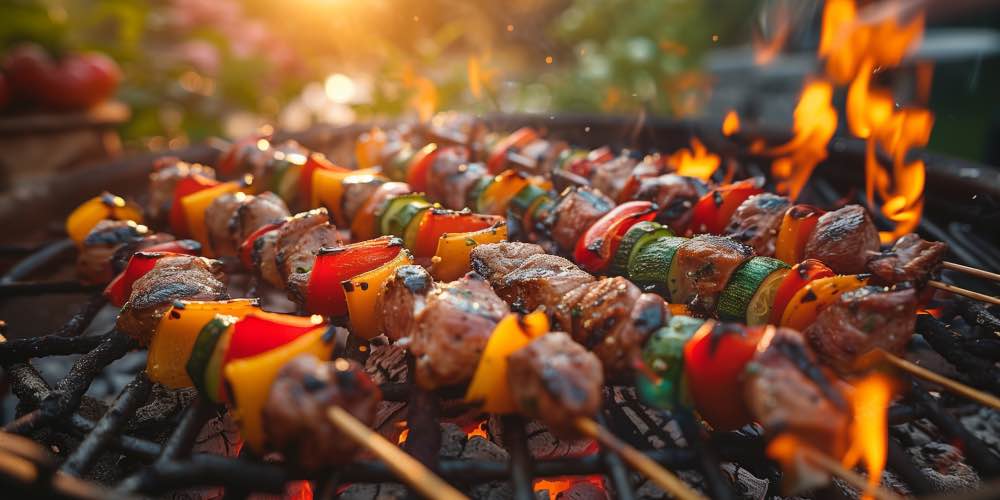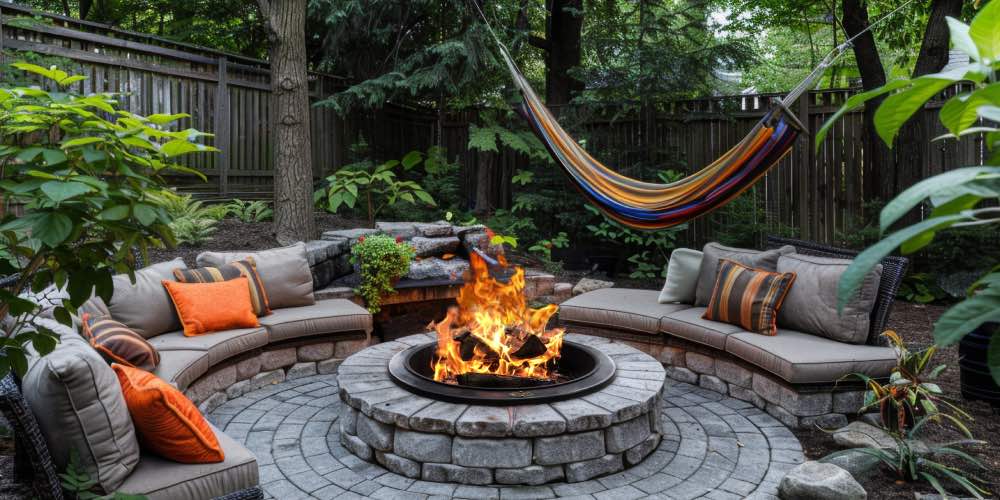Fire pit cooking transforms ordinary outdoor meals into extraordinary, flavorful feasts. Whether you're grilling a steak, slow-cooking stew, or toasting marshmallows, a fire pit opens up a world of fun and tasty possibilities. Below, we’ll dive into the versatility, techniques, and tools needed to master the art of fire pit cooking while enhancing your outdoor experience.
The Versatility of Fire Pit Cooking
Fire Pits vs. BBQ: Why Choose Fire Pit Cooking
When comparing traditional BBQ grills to fire pit cooking, there’s one clear winner if you're seeking a rugged, natural experience: fire pits. The flames, smoke, and aroma of cooking over an open fire elevate both the flavor and the atmosphere. Plus, fire pits provide a larger cooking surface, allowing you to easily grill, roast, and slow-cook all at once. In a nutshell, a fire pit is both a cooking tool and a social centerpiece.
The Social Experience of Cooking Over an Open Fire
Cooking over a fire pit is more than just making food—it’s about creating a memorable experience. Imagine sitting around the flames with friends and family, everyone taking turns roasting their skewers or tending to the fire. The warmth, the conversation, and the scent of wood-smoked goodness combine to create a rich outdoor dining event that a gas or charcoal grill just can't replicate. Have you ever noticed that food just tastes better near a bonfire? Yes, the food does taste better, but it’s also the total experience you’re enjoying.
Key Tools and Safety Measures for Fire Pit Cooking
Essential Equipment: Grates, Tongs, and Skewers
Your fire pit cooking experience starts with having the right tools. A sturdy cooking grate, such as the Walden BBQ cooking grate, is essential for grilling meats and vegetables directly over the fire. Long-handled tongs are really helpful for safe food handling, while skewers (either stainless steel or wooden) allow for versatility—perfect for kebabs, sausages, or even marshmallows.
Safety First: Keeping Water and Fire-Resistant Gear Handy
Safety should always be a top priority. Keep a bucket of water or a spray bottle nearby to douse any unexpected flare-ups. Fire-resistant gloves and an ash shovel are also wise additions to protect yourself and keep the cooking area clean. Remember, the more prepared you are, the smoother the fire pit cooking process will be.
Controlling the Fire Like a Pro
When you’re fire pit cooking, one very important tool to have handy is a good fire poker. Live fire cooking offers the versatility of moving the logs around to create varied spots of heat, flame and smoke. Having the right fire poker allows you to control the fire to make the most of your masterpiece. And when you need to prompt your fire to deliver extra heat or flame, a blow-through fire poker like the Walden Stoker Poker™, gets the job done right.
Selecting the Right Firewood for Cooking
Hardwood Choices: Oak, Hickory, and Fruitwoods for Flavor
Choosing the right firewood can make or break your fire pit cooking. Hardwoods like oak, hickory, and mesquite burn longer and hotter, giving you consistent heat and adding layers of flavor to your food. Fruitwoods, such as apple or cherry, can infuse a sweet, smoky flavor into meats and vegetables—perfect for adding a gourmet touch to your meal.
Avoid Softwoods: Why Pine and Cedar Are Not Ideal for Cooking
While it might be tempting to use any wood you have on hand, avoid softwoods like pine and cedar. They contain sap and resin, which produce a lot of smoke and can leave an unpleasant taste on your food. More importantly, softwoods can release harmful toxins when burned, making them unsuitable for cooking.
Fire Pit Cooking Techniques for Meat, Veggies, and More
Grilling Over the Fire: Perfecting Steaks and Burgers
Grilling over a fire pit requires a little finesse, but the results are well worth it. For the perfect steak or burger, start by ensuring the fire is hot enough. Place the meat directly over the grate and sear each side before moving it to a cooler section of the fire to cook through. This two-zone technique ensures juicy, evenly cooked results.
Roasting Vegetables and Slow Cooking Stews
Vegetables can take on a whole new level of flavor when roasted over a fire pit. Wrap them in foil with some oil and herbs or place them directly on a grate. For a heartier option, consider slow-cooking stews in a cast-iron pot, letting the gentle heat work its magic over several hours.
Sweet Treats: Elevating S’mores and Roasting Fruit
A fire pit wouldn’t be complete without a sweet treat. While classic s’mores are a must, try roasting fruits like peaches, apples, or pineapples. A light brush of butter and cinnamon will caramelize the sugars, creating a warm, sweet dessert that’s perfect for finishing off your meal.
Advanced Techniques: Smoking and Cast Iron Cooking
Adding Smoky Flavor with Wood Chips
To add smoky depth to your meats, try incorporating wood chips. Soak chips like hickory or applewood in water and then toss them directly onto the hot coals. The chips will smolder, releasing a rich, smoky flavor that enhances steaks, ribs, or even poultry.
Mastering Cast Iron Cooking: From Stews to Cheese Melts
Cast iron is a fire pit cook's best friend. Its even heat distribution makes it ideal for everything from simmering stews to creating crispy cheese melts or grilled sandwiches. A well-seasoned cast-iron skillet or Dutch oven is indispensable when cooking meals over an open flame.
Hosting a Fire Pit Party: Tips for Engaging Everyone
Creating a Fire Pit Menu: BBQ, Skewers, and Sweets
A fire pit party menu should be simple yet satisfying. Offer a variety of options—think BBQ ribs, chicken skewers, grilled veggies, and of course, dessert. Incorporate crowd-pleasers like roasted marshmallows, and provide roasting sticks for your guests to join in the fun.
Atmosphere Matters: Lighting, Seating, and Safety Considerations
To create an inviting atmosphere, add string lights or lanterns for soft lighting. Arrange comfortable seating around the fire pit, ensuring there’s plenty of space to move around safely. Keep extra blankets handy for warmth, and always have a clear pathway to provide for easy walking around the fire pit and chairs.
FAQs
Q: What type of firewood should I use for fire pit cooking?
A: Hardwoods like oak, hickory, and fruitwoods are best for fire pit cooking due to their slow-burning nature and flavor-enhancing properties.
Q: How can I avoid excessive smoke when cooking over a fire pit?
A: Ensure your firewood is dry and well-seasoned. Avoid using softwoods like pine, which tend to produce excessive smoke. Use a fire pit that’s designed with good air flow for clean wood combustion.
Q: What are the best vegetables to grill over a fire pit?
A: Some great options include bell peppers, zucchini, corn, and asparagus. These veggies hold up well to direct heat and absorb smoky flavors beautifully.
Q: How do I keep my fire pit cooking safe for guests?
A: Keep a bucket of water or fire extinguisher nearby, and ensure the cooking area is free of flammable materials. Provide guests with fire-resistant gloves if they’re helping with cooking.
Q: What are the top tools for mastering fire pit cooking?
A: Essential tools include a sturdy grate, long-handled tongs, skewers, and a cast-iron pot or skillet for versatile cooking options.
By following these tips and techniques, you'll be ready to master fire pit cooking and impress your guests with flavorful BBQ, perfectly grilled veggies, and delicious desserts.









Leave a comment
All comments are moderated before being published.
This site is protected by hCaptcha and the hCaptcha Privacy Policy and Terms of Service apply.